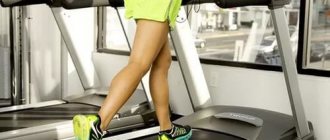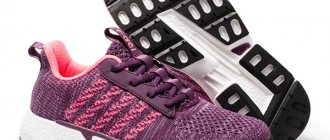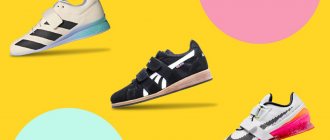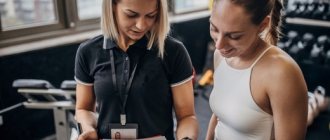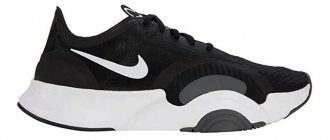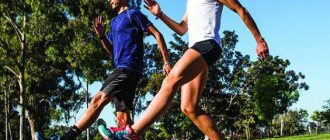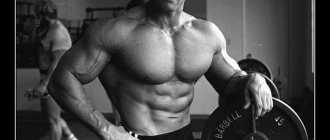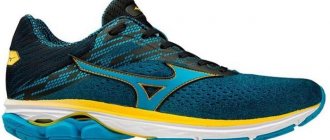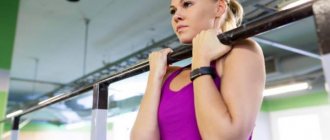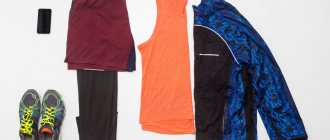While jogging, the athlete's muscles and joints experience enormous stress from impacts on the ground. Therefore, the most important component of an athlete's equipment is running shoes. Properly selected shoes guarantee running without discomfort and injury.
Renowned triathlete and coach Joe Friel
in one of his interviews he said: “Running shoes have become so technologically advanced that the wrong pair of sneakers can cause injury.” And we couldn't agree more! Broken nails, calluses, pain in the feet, knees and back are the most common injuries from training in the wrong shoes.
Therefore, today we propose to understand one difficult question: what should you consider when choosing sneakers? We are with the manufacturer of high-tech footwear Under Armor
and RunLab store shoe selection specialist
Igor Brykov
have collected tips that will help you not get lost in the assortment and purchase that perfect running pair.
View this post on Instagram
Which sneakers should you choose for running?
For many, the answer is obvious, but we continue to see people running in sneakers, futsal shoes, tennis and volleyball shoes. Only running shoes are suitable for running!
There will probably be objections about the fact that they used to run in Moscow sneakers and nothing. You can even run in slippers or ankle boots. Let's approach running rationally and take care of our health . We don’t know how everyone used to run in sneakers before, but it definitely didn’t bring any benefit to the joints.
Differences from usual
Almost all of the previous characteristics are designed to answer the question of how running shoes differ from regular ones. After all, this is one of the most common mistakes: what we walk in is what we run in. Do not make such a mistake - it will most likely end in discomfort from training and injury.
Now you can probably figure out which shoes are suitable for morning running as part of sports training, and which ones are suitable for evening walks, as they say, “on the go.” These are two completely different things that should never be mixed.
How to choose the right sneakers?
Running shoes will be more comfortable and last longer if they are selected for their intended purpose. To do this, you need to decide on the running location, surface, and season. Adequately assess your level of running fitness, check your body mass index .
Type of coverage and season
The main types are asphalt and off-road. Off-road conditions include dirt, mud and snow. For asphalt you need a minimal tread and good shock absorption; for dirt and snow - an aggressive tread on a harder sole. If your feet are cold, sneakers with a membrane - usually Gore-tex - are suitable as an insulated option.
Read more about the types of sneakers in our articles:
- Sneakers for running on asphalt
- Winter running shoes
- Off-road running shoes
Purpose: training or competitions
Training sneakers are used for daily jogging, so cushioning, stabilization, and wear resistance are important in them. Because of all the technology, such sneakers are heavier than competition ones and you can’t set records in them. But they have a different goal - to maintain healthy muscles and joints, and they do this very well.
Competition sneakers are lighter than training shoes, have a thinner sole, and a minimum of support and stabilization systems. Usually such sneakers are called “marathon shoes”. Everyone decides for themselves whether such sneakers are needed. If you don’t have a goal to set personal records, marathon runners are unlikely to be useful.
- Marathon running shoes
Pronation and fitness level
In skiing or cycling, you can still start with simple equipment, and then gradually move on to professional equipment. This principle does not work in running. Less experienced runners need more technical running shoes . They compensate for weak stabilizer muscles and relieve stress on ligaments and joints. Sneakers with support are a must for people with excess weight, flat feet, and problematic joints.
Runners with experience and proper technique can run in any running shoes without risk to health, practice “natural” running, and even run barefoot. Technical runners love marathon shoes , lightweight running shoes for maximum speed. For beginners, such shoes can lead to injuries, so we recommend that beginners use them only for working on equipment.
So, the worse the technique and physical form, the more cushioning and stability you need.
Pronation is an important factor when choosing running shoes, but it does narrow down your shoe selection. In this case, orthopedic insoles will help. If for some reason the running shoes for overpronators , choose a neutral model and try it on with your insoles.
Read on topic:
- What is pronation and supination?
- Sneakers for running on asphalt
- Sneakers for flat feet
- Marathon running shoes
Depreciation
The shock absorber was provided by nature before the advent of technological running shoes - this is the foot. For proper foot function when running, you need trained muscles and correct running technique . All runners pump up their feet, knees, back, abs - in general, they focus on general physical training. This takes time, but while you're working on it, run in shoes with good cushioning.
Each manufacturer has its own developments in depreciation, which it considers unique. Here are some of them:
- Adidas - Boost
- Asics - special silicone Gel, FlyteFoam
- Hoka - Infuze Eva and Rmat foam, ProFly technology and other technologies
- Mizuno - Wave system
- Nike - Zoom air system, ZoomX , React foam
Read on: How are the soles of running shoes made?
Photo: triathlete.com
Ventilation
Ventilation in sneakers is much more important than insulation . Most running training and competitions take place in the hot season, and you don’t want to run with “burning” feet. Ventilation is also important for trail runners to overcome fords. Breathable sneakers quickly remove moisture and your feet become dry again.
Of course, to remove moisture from your shoes, you need good running socks - synthetic, moisture-wicking ones. Cotton ones will hold water regardless of the sneakers.
Almost all running shoe manufacturers produce running shoes with a membrane. The membrane is a special material that breathes and does not allow moisture to pass through . Sneakers with a membrane will keep your feet dry, but if you scoop up water through the top, they will gurgle until the end of the distance. Therefore, you should think carefully about whether you need a membrane at a distance. We prefer to use the membrane only for training in the city or park, where there is no chance of water getting through the upper of the shoe.
Drop or drop
Drop or drop is the difference between the sole height of the front and rear of the shoe. Not the most important factor in choosing running shoes, but you need to understand its purpose.
The most common drop is 10 mm. The minimum is 4 mm (if you have met a smaller one, write in the comments). The higher the drop, the more comfortable it is to run from the heel. Moreover, the difference does not depend on depreciation. Sneakers with good cushioning can have minimal drop, such as the Hoka One One . But still, minimal drop is often combined with minimal cushioning - these are sneakers for personal bests.
General recommendations
A few more general recommendations from experts will make it easier for you to find the perfect pair of sports shoes.
- Before you go to the store, decide which model you need: its characteristics, brand, price range.
- Sneakers bought at the local market for $5-10 will lead to the fact that after the first workout you will no longer have the desire to run. Therefore, save up some money and buy good, high-quality shoes in a specialized store.
- It is better to make a purchase in the evening, when your feet are a little swollen after a day of work.
- Listen to the advice of sales consultants, do not hesitate to ask them questions.
- Monitor the quality of the seams and material: will they tear after a week of intense jogging, will cracks form?
- When trying on, it is advisable to run around a little. It’s one thing when shoes sit statically on your foot: they can be quite comfortable and convenient. But as soon as you add more movement, various shortcomings may appear (poor fixation, loose heel, tightness of the toes).
- It is recommended to change them every 1500-2000 km.
As you can see, in order to choose running shoes wisely, you need to take into account many factors and have a really good understanding of the characteristics of sports shoes.
How to choose sneaker size?
Foot width
Choose a size not only by foot length, but also by width. Some brands make special options for wide feet. They are usually marked Wide . For example, Asics and Hoka . If we consider standard models, then each brand has its own “preferences” for the last. Nike and Asics have a narrow last, Saucony and Brooks have a wide last, Mizuno has a narrow heel and wide toe. Keep this in mind when thinking about which brand of sneakers to choose.
How to choose the right sneaker size?
The size of running shoes depends on your goals . For short distance running, take 2-3 mm more. For long ones - by 5-8 mm. For trails, you can take it with a margin of up to 10 mm, provided that the leg does not dangle.
Always tie your sneakers when you try them on. Start tightening from the bottom loops to get the shoe on your foot as best as possible. Lacing allows you to individually customize the upper of the shoe to suit the characteristics of your foot, read how to lace sneakers .
Some tips for trying on sneakers
- It is best to try on sneakers with your running socks fully laced and in a standing . If you have orthopedic insoles, be sure to take them with you to the fitting.
- If you have a non-standard foot size, don't just stick to shoes for your gender. Men's shoes can suit girls with large feet, women's shoes can suit men with small and narrow feet.
- When trying on sneakers, pay attention to the fit. The upper material should fit around the instep and the heel should remain stationary . free space only in the area of the fingers. If you can move your fingers like you're playing a piano, you're fine.
Cheat sheet for choosing running shoes
- Only running shoes . Don't skimp on shoes and your health.
- When choosing a model, consider pronation and body characteristics : the worse your physical shape, the more cushioning and stability you need.
- Running shoes should always have free space for the toes : for short distances - 2-3 mm, for long distances - 5-8 mm, for mountain marathons - up to 10 mm.
- Consider the type of coverage and season .
- Don't switch to new sneakers right away . For the first few weeks, alternate between old and new to allow your sneakers and your body to adapt.
What to consider before buying running shoes
Running shoes are too general a concept. For what kind of running? Short or long distance? Along the stadium, paths in the park, forest paths, mountainous terrain? For everyday runs, cross-training, competitions?
Focusing on the tasks, shoes are selected according to the level of shock absorption, thickness and rigidity of the sole, tread height, and weight. By voicing them to the sales consultant, you will significantly narrow down your choice and save time on finding a suitable option.
The second important point is individual characteristics. These include:
- anatomical structure of the foot - its width, instep height, shape of the toes;
- features of foot placement when moving – straight or rolls in/out; land on your heel or toe;
- training of the foot muscles and general physical fitness in general;
- body weight;
- foot size.
The level of shock absorption of the shoe, the difference in height between the heel and toe, and the presence in the design of the sneaker of various stabilizing elements that provide fixation and support for the foot depend on these features.
It is also important what climate and weather conditions you plan to run in. Taking this into account, the upper of the sneaker is chosen - ventilated, waterproof, insulated, low or high, with or without a protective liner to prevent debris from getting inside.
Trail running shoes are significantly different from pavement running shoes.
Useful tips
To make using sneakers comfortable and running safe, you need to use the following recommendations:
- Wear special socks for running, as they promote good ventilation.
- Be careful when purchasing shoes without examining and trying them on to avoid counterfeiting or making a mistake with the size.
- Shoes should be changed after traveling 600-1200 km, even if the sneakers seem suitable in appearance.
- Products are washed once a month.
Running shoes are high-tech shoes that need to be chosen taking into account many factors. The wrong pair can cause serious harm.
Use special running socks
Shoes should be changed after traveling 600-1200 km
Do not buy without inspection and fitting
Selection criteria and common mistakes
To choose the right professional sneakers, you need to consider the following criteria:
- compliance in size and degree of depreciation;
- place of running and purpose of using shoes;
- setting and other anatomical features of the foot;
- good level of flexibility of the sole in its forefoot;
- use of “breathable” materials when sewing;
- placement of lacing in the center of the product;
- the presence of a removable insole.
Not every lover of a healthy lifestyle can choose the right running shoes. The most common mistakes:
- weak fixation of the heel, as a result of which it “walks”;
- resting the finger on the toe (leads to injury, chafing);
- excessively tight fixation;
- use of socks not intended for running;
- lack of ventilation in shoes;
- bad fitting of sneakers.
Failure to follow these selection rules can result in injury or problems with the skin of your legs.
Motivation. The beginning of all beginnings
Every runner, sooner or later, before or during running, has to answer the questions: “Why?” - “why am I doing this?”, “why am I wasting my free time, which quite possibly could be spent on something else?”, “why do I need all this stress, although before that I lived quite well without it?” These questions arise because you are transferring yourself from a state of stability to which your body, your brain, your subconscious are accustomed, into a state of instability, which is completely unusual. You consciously start the process of change - from consciousness, thanks to certain initial motives: you want to lose excess weight or prepare for the first race, but the body and subconscious begin to resist changes. In order to “help” the body and subconscious mind adapt to new conditions, you need to use “motivation” - a system of building meanings - motives, with the help of which you explain to the body and subconscious mind about the need for changes not only BEFORE starting running, but also during the start period and beyond - to maintain the training process.
Dialogue is the best way to agree on something. Use the “internal interview” technique—an artificial conversation “with yourself.” Asking "Why?" and when answering, you must always speak only about yourself and only the sincere truth: about your feelings, about your goals, about your personal desires, leaving aside imposed social norms and rules. Examples of correct wording:
- “Why do I want to start running? - I want to lose weight”, “Why do I want to lose weight? “I gained excess weight during the fall-winter, during this period I did little training and this way I want to get rid of it.”
- “Why do I want to start running? – I want to improve my health”, “Why do I want to improve my health? “I want to live my life with less pain, maintaining the physiological parameters of a healthy person for as long as possible.”
- “Why do I want to start running? – I want to be in nature more often,” “Why do I need to be in nature more often? “Because this is the best vacation for me.”
- “Why should I keep running? “For me, running is a great emotional reboot.”
- “Why should I keep running? — Because I really like to travel. Running and participating in competitions are a great reason to travel,” “Why do I travel? “Because I’m learning foreign languages and I want to have more opportunities to apply my knowledge.”
- “Why should I keep running? – I want to run a marathon. The Moscow Marathon will take place in six months, and I know that in order to run it successfully, I need to maintain my physical shape.”
Well-tuned, true motivation always lies in the plane of real personal gain. Realize your personal benefits from starting or continuing running using this technique and you will always have “iron” foundations that will outweigh any doubts and any subconscious arguments. “Personal benefits” may change over time, but the fact is, and it is true, that they certainly exist for both new runners and Kenyans who run sub-2:20 marathons.
Asics Gel Nimbus 20
For 20 years, Gel Nimbus have been a soft, comfortable, neutral shoe ideal for slimmer feet. Although it's not just a women's shoe, Nimbus has a devoted men's following. The newest generation Nimbus 20 has a new gel cushion and a more secure fit around the midfoot, meaning you don't have to tighten the laces too much. Moreover, the new 3D printed mesh upper is a much better design than the older versions of the shoe. The cost of ASICS Gel Nimbus 20 is 8390 rubles.
Breathable upper
When it's warm outside, your feet need maximum ventilation. Air circulation and quick removal of sweat from the foot are best ensured by mesh synthetic materials. By airing the skin, they reduce sweating and prevent unpleasant odors.
The ideal top is without seams, made of soft material. Only the heel is hard (the heel remains soft!), and in SUVs there is also a sock to protect the toes from hitting rocks and snags. At the same time, the stiffening elements do not rub anywhere, do not put pressure on the Achilles tendon, and the entire upper structure secures the ankle well.
If you plan to run in mud and slush, take care of protection from moisture. The waterproof GoreTex membrane is found in many SUVs, for example in the men's ASICS GEL-FUJISETSU GTX 2 (9.9 thousand rubles) or the women's Mizuno Wave Rider 20 (11 thousand rubles). True, it is hot in such shoes in summer.
Coating
The first place to start is to decide where you plan to run. All sneakers are divided into two groups: road or asphalt and trail. The first ones are intended for training on asphalt, in an arena, that is, for flat surfaces. The latter are designed for cross-country running.
Trail sneakers have a stiffer sole with an aggressive tread or spikes, an upper made of wear-resistant material, and may have protective inserts that protect the foot from stones, roots and branches on difficult terrain. Road shoes are usually lighter and have a soft, flat sole.
Adidas Solarboost
Great shoes for training or marathon. The upper consists of fibers that provide a sock-like feel with the addition of an upper guide that adds support to the shoe designed to relieve pressure on the Achilles. Very comfortable and reliable sneaker. The cost of adidas Solarboost is 10,990 rubles.
Nike Air Zoom Pegasus 35
Designed for every level of running, this women's running shoe from Nike features a subtly soft Cushlon foam midsole specifically designed for women's feet. This is a modern update to a popular shoe that has been around for 35 generations. It features some new changes based on feedback from some of the world's top athletes. While the breathable mesh upper remains the same, there is a new collar design that points away from the Achilles for added comfort and a new shape with responsive cushioning that improves traction and flexibility. The cost of Nike Air Pegasus 35 is 9900 rubles.
Saucony Ride ISO
Saucony brings the new ISOfit upper to a soft, comfortable outsole that feels like it's cradling your arches. The Ride ISO women's neutral running shoe keeps you lightweight, while the Everun upper midsole has three millimeters of responsive foam under the lining for energy return, plus bonus Powerfoam for a smoother stride. We also liked the new ISOFit lacing system, which allows you to customize how tightly you want your laces to fit around your foot. Overall, this is a great marathon shoe at a great price. The cost of Saucony Ride ISO is 9900 rubles.
adidas adidas Solarboost Asics asics Gel Nimbus 20 hoka hoka One One Cavu New Balance New Balance 1080v8 Nike Nike Air Zoom Pegasus 35 saucony saucony Ride ISO
